Abstract
There is an increased interest for battery electric vehicles in multiple sectors, including agriculture. The potential for lowered environmental impact is one of the key factors, but there exists a knowledge gap between the environmental impact of on-road vehicles and agricultural work machinery. In this study, a life cycle assessment was performed on two smaller, self-driving battery electric tractors, and the results were compared to those of a conventional tractor for eleven midpoint characterisation factors, three damage categories and one weighted single score. The results showed that compared to the conventional tractor, the battery electric tractor had a higher impact in all categories during the production phase, with battery production being a majority contributor. However, over the entire life cycle, it had a lower impact in the weighted single score (−72%) and all three damage categories; human health (−74%), ecosystem impact (−47%) and resource scarcity (−67%). The global warming potential over the life cycle of the battery electric tractor was 102 kg CO2eq.ha−1 y−1 compared to 293 kg CO2eq.ha−1 y−1 for the conventional system. For the global warming potential category, the use phase was the most influential and the fuel used was the single most important factor.
1. Introduction
According to IPCC [1], reaching net-zero emissions of greenhouse gases (GHG) is required in order to limit and stabilise human-induced global temperature increase. To limit global warming to 1.5 °C above pre-industrial levels, the global carbon budget (amount of CO2eq. that can be emitted before that temperature is reached) must be kept between 300 and 900 GtCO2 [1]. Globally, agriculture has a major impact on emissions of GHG. In 2010, 21–24% (9.5–11.9 Gt CO2 eq. y−1) of global GHG emissions originated from the AFOL (agriculture, forestry and other land use) sector [2,3]. Of this, roughly half was attributable to agricultural production, and 0.4–0.6 Gt CO2 eq. y−1 of that to agricultural machinery use. To reach the net-zero emissions goal, agriculture cannot be ignored and environmentally friendly solutions for agriculture are needed.
The European Union (EU) has set the goal of being carbon net neutral by 2050 [4]. The Swedish government has established similar goals, i.e., to have a fossil-free vehicle fleet by 2030 and to be carbon net neutral by 2045 [5]. This includes areas that have traditionally been difficult to shift from diesel to renewables, such as agriculture, forestry and mobile work machinery. These sectors place high demands on their vehicles, so robust, cost-effective solutions are needed. One such solution is implementation of battery electric vehicles (BEV), for both on-road and nonroad vehicles, using electricity from fossil-free sources. However, automotive batteries have been shown to have a large environmental impact during their production [6,7,8], although EVs have also been shown to have a lower impact during the use phase due to higher driveline efficiency and lower fuel impact [9,10]. In the agriculture sector, multiple research projects and demonstrations of BEVs for field work have been conducted, with promising results [11,12,13,14,15]. It has therefore been concluded by the World Economic Forum [16] that electrification is a potentially cost-effective way of reducing GHG emissions in agriculture. There is significant interest from policy makers in a more renewable food production system.
In previous studies by our research group assessing the production capacity and economic impact of autonomous battery electric tractors through simulations [17,18], they were shown to have a comparable work rate and lower total annual costs for certain system topographies. One of the main arguments for changing from a few large diesel-powered tractors to multiple smaller battery electric tractors is the potential environmental benefit in replacing diesel with electricity that has a smaller environmental footprint. For this change to be feasible, we have shown that autonomous operation is a prerequisite, due to economic factors [18]. While a multitude of environmental impact assessments and life cycle assessments (LCAs) have been performed for agricultural machinery [19,20,21], Li-ion batteries [6,7,22,23], components in the electric driveline [24,25] and on on-road BEVs [9,26], there is a lack of LCAs on electric tractors and other electric mobile work machinery.
Many studies look exclusively at the climate impact in the form of GHG emissions when performing an LCA, but several other impact categories are of interest in order to obtain a more complete understanding of the impacts of a system. In a review of existing LCAs on automotive batteries by Aichberger and Jungmeier [8], one of the main conclusions was that inclusion of more impact categories than GHG and energy use is recommended for LCAs concerning automotive batteries, as also stated by Loon, et al. [27]. For example, availability of key materials and resource scarcity are potential challenges connected with automotive batteries [6]. Arvidsson et al. [28] recommend the use of several impact factors in LCA of emerging technologies because new technologies may lead to different environmental impacts than the systems they replace. In LCAs of agricultural systems, several other impact categories are of interest, notably eutrophication of freshwater and the effect on biodiversity. By combined studies of impact factors for agriculture and BEVs, a more thorough understanding of the environmental impact of battery electric field machinery can be gained, and a more informed comparison to the systems used today can be made.
The aim of the LCA performed in this study was to determine the environmental impact of a self-driving BEV tractor system and compare it with that of a contemporary diesel tractor system for a Swedish grain farm. The hypothesis tested was that changing to an electricity-based system leads to lower environmental impacts.
2. Materials and Methods
2.1. Goal and Scope
This LCA study assessed the potential environmental impact of an autonomous BEV agricultural vehicle system and compared it with the impact of a conventional internal combustion engine (ICE) diesel-powered system used today. The environmental impact was represented by characterisation of several midpoint and endpoint impact categories, damage assessment and a weighted single score, as explained in further detail in Section 2.5. As midpoint impact categories can be used as a measure of emission intensity, and endpoint impact categories as a measure of the resulting impact on human health and the environment [29], determining both gives a broader picture of a system’s impact.
The scope of the LCA was limited to production and assembly, use phase and end-of-life of two small BEV agricultural field tractors, as described in Section 2.1. Comparisons were made between a vehicle system consisting of these vehicles and a vehicle system consisting of a conventional manned diesel-powered tractor. A full cradle-to-grave (CTG) analysis was made, and the gate-to-gate (GTG) aspect was also assessed separately.
The tractors were assumed to be used on a Swedish grain farm of 200 ha growing winter wheat, spring wheat, barley and oats, in the manner described in Lagnelöv, Larsson, Nilsson, Larsolle and Hansson [17]. The LCA methodology presented in the ISO 14040:2006 standard [30] was used, together with scalable life cycle inventories (LCIs) for the vehicle glider, the battery and the driveline. LCIs for conventional tractors, electric vehicles and trucks were used, due to data shortages. As the focus of the study was on the impact of the machine system and on comparison with the systems used today, original LCIs for components were not created and secondary sources were used when possible, after verification.
To account for the emerging state of the technology studied, a process-based, consequential LCA was performed to test the hypothesis that a system of autonomous BEVs reduces the climate impact in agricultural machinery systems compared with a contemporary diesel tractor system doing the same work under the same conditions.
Vehicle Definitions, System Boundary and Functional Unit
The BEV system analysed consisted of two autonomous tractors with 50 kW permanent magnet synchronous machine (PMSM) electric motors and 100 kWh nickel cobalt aluminium (NCA) Li-ion batteries. Each vehicle had one on-board battery and an additional battery for rapid battery replacement, making a total of four 100 kWh NCA batteries (two per vehicle). Because the vehicles were assumed to be autonomous, it was assumed that they had no cabin. This vehicle system has been shown in previous studies to have a high theoretical work rate [17] and to compare favourably to contemporary tractor systems in economic terms [18]. The infrastructure necessary for charging the vehicle system was also included in the analysis. It comprised two 50 kW CC/CV DC chargers and a battery exchange system.
As the reference case, a 250 kW contemporary diesel tractor was assessed using the same methods and models. Production, fuel, repair, maintenance and end-of-life steps were included in the life cycle of the conventional vehicles and in that of the BEV vehicles.
The system boundary of the study started at manufacturing of the main vehicle components and ended after the end-of-life phase, as shown in Figure 1. As the focus of the study was on machinery, the agricultural part of the use phase was not modelled other than in terms of energy demand [18], as it was assumed to be similar for the cases studied. In addition, the autonomous system only included the hardware on the vehicle and a single base station, while any additional infrastructure was not included.
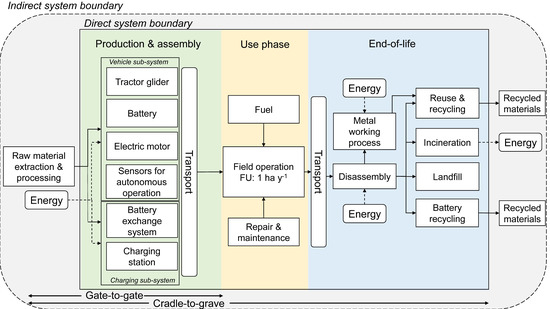
Figure 1.
System boundary of the studied system. Direct system boundary (square) shows the system described in the article—production & assembly (green), use phase (yellow) and end-of-life (blue). The indirect system boundary (dashed border rounded square) shows processes that are not specifically studied or described, but are included in the result. The functional unit (FU) is included, and energy flows are represented by dashed arrows.
The functional unit was set as one average hectare of arable land growing cereal, as defined and with the machinery operations simulated and cereal data used in Lagnelöv, Larsson, Nilsson, Larsolle and Hansson [17] during an average year, giving a functional unit of 1 ha−1 y−1.
2.2. Inventory Analysis
Inventory data for autonomous vehicles are sparse, and data for tractors are less available than data for on-road heavy duty vehicles. It was assumed that data from other vehicles can be scaled, adjusted and fitted to the autonomous system, mostly concerning electrification and autonomisation of vehicles (Table 1). The inventory and subsequent analysis were made in the LCA software SimaPro (v.9.0.0.49, PRé sustainability, Amersfoort, The Netherlands) [31]. A complete inventory list can be found in Supplementary Material S1.

Table 1.
Components included in life cycle assessment (LCA) of the battery electric vehicle (BEV) and internal combustion engine (ICE) cases. Categories marked with * were included, but to a reduced extent. Dataset names and complete inventory list can be found in Supplementary Material S1.
Transport in the inventory was divided between freight shipping and road transport. The road transport was assumed to be perfomed by truck or lorry in the 16–32 tonnage interval and with a Euro 6 emission standard because it is the most common truck used in Sweden and is also common in Europe according to logistics experts (A. Lagnelöv, J. Peterson & C. Brus, VDAB, Uppsala, Sweden, Personal communication 2021-04-08).
2.2.1. Glider
The inventory for the glider and other nondriveline parts of the vehicle can be found in several publications. Wolff, Seidenfus, Gordon, Álvarez, Kalt and Lienkamp [32] give an inventory for a general heavy-duty vehicle, while Lee, et al. [46] and Mantoam, Romanelli and Gimenez [20] focus on agricultural tractors. However, their inventories include the cabin and the conventional driveline, neither of which was included for the autonomous battery electric drive (BED) tractors in this study. According to Nemecek and Kägi [33], on-road heavy duty vehicles like lorries can be used as an approximation for material composition and assembly of tractors where other data sources cannot be found. Because the data in Wolff, Seidenfus, Gordon, Álvarez, Kalt and Lienkamp [32] are separated into machine parts and are scalable, they were selected for use. A glider without internal combustion engine (ICE) and cab was constructed and scaled to a total glider weight of 2500 kg, giving a scaling factor of 63.5% compared to the source data.
2.2.2. Battery
The battery considered in Lagnelöv, Dhillon, Larsson, Nilsson, Larsolle and Hansson [18] was a Li-ion battery with an NCA positive electrode (LiNi0.8Co0.15Al0.05O2) and graphite as the negative electrode (NCA-C). Inventory data for a NCA-C battery module taken from Le Varlet, Schmidt, Gambhir, Few and Staffel [34] were used to represent this battery. Some materials were not found in the database, so recommended proxies listed in Siret, Tytgat, Ebert, Mistry, Thirlaway, Schultz, Xhantopoulos, Wiaux, Chanson, Tomboy, Pettit, Gediga, Bonell and Carrillo [45] were used. In addition, the electricity used for battery assembly and some manufacturing was switched from Norwegian mix in the original article to Swedish mix, due to the focus of the present study being the Swedish context, but component manufacturing was assumed to use either local or Chinese electricity mix [34,40].
It is worth noting that the inventory in Le Varlet, Schmidt, Gambhir, Few and Staffel [34] is for residential batteries for local energy storage, which is a different use from that of electromobility. However, the inventory data were based on batteries for use in electric vehicles [9,47,48,49,50] and were therefore considered applicable. Because the battery studied in Lagnelöv, Dhillon, Larsson, Nilsson, Larsolle and Hansson [18] was specified in terms of energy content (in kWh) and the battery LCI was given in mass units, a gravimetric energy content of 0.10 Wh g−1 taken from Le Varlet, Schmidt, Gambhir, Few and Staffel [34] was assumed.
2.2.3. Battery Recycling
Standardised general invenory data for battery recycling, including resource use and credits, are provided as part of the EU product environmental footprint (PEF) documentation for batteries in mobile applications (PEFCR) [45]. The PEFCR data cover the broader-term Li-ion battery but are modelled specifically on LCO, NMC, LFP and Li-Mn chemistries. It was assumed that this was an adequate stand-in for the recycling part of the chemistries (NCA-based) used in the model in this study. Recycled materials were used as credits and replaced virgin material in applications outside the system boundry, modelled as a negative flow.
2.2.4. Electric Motor
A gate-to-gate LCI for a general PMSM electric motor of variable power and torque was performed by [51], with additional data given in [35]. It details the production of the motor, but not the rest of the driveline. End-of-life is also omitted. However, this still served as a good base for the electric machines used in the driveline in the present assessment, as PMSM is the most common electric motor technology used in electric vehicles [51] and the resolution is high. This value was verified with values for an electric motor of the same power presented in Spielmann, et al. [52], which, due to lower resolution, had lower impacts but agreed on the key impact points and impact magnitudes.
2.2.5. ICE Driveline
The conventional tractor used for comparison was assumed to be a 250 kW tractor, using field tractor data from Nemecek and Kägi [33]. This included raw material extraction, manufacturing, assembly, maintenance and disposal steps of the life cycle. However, these factors are often aggregated to the manufacturing phase in the presentation of results in this paper. The model used the tractor mass as a quantifying unit for the inventory. The unloaded weight was assumed to be 10,800 kg, which was based on the average weight of modern tractor models with approximate power 250 kW (Valtra S294, Fendt 933 Vario, John Deere 7R330). The mass and inventory data were verified with data taken from [20] for a 246 kW tractor with mass 10,950 kg. The exact composition tends to vary between data sources, but steel and ductile iron are key components, with rubber (in the form of tyres) and oil frequently cited as a large part of the maintenance materials used [20,32,33,46]. A comparison of key materials from different sources by weight can be seen in Figure 2.
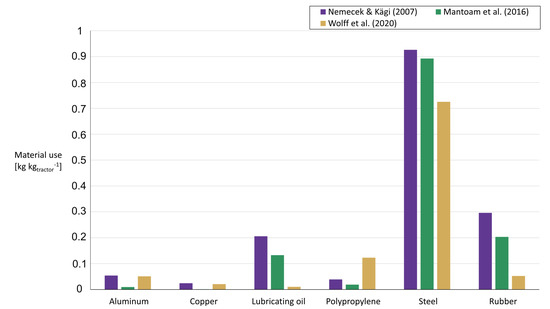
Figure 2.
Material use in the assembly and maintenance phases of the vehicle body for key materials by weight [20,32,33]. Note that the data from Wolff, Seidenfus, Gordon, Álvarez, Kalt and Lienkamp [32] do not include maintenance and repairs, and hence the usage of steel, rubber and lubricating oils is lower than in the other sources.
2.2.6. Autonomous System and Sensors
Because there are no industry standards for the equipment used for self-driving vehicles, information on the components in these vehicles was gathered from previous studies and industry practitioners. The sensors listed in Table 2 represent a realistic setup according to industry experts (L. Ahlman (Agrodroids), F. Löfgren (Dynorobot), A. Stålring & F. Gradelius (Tegbot), Linköping, Sweden, Personal communications). This is in line with the technology recommendations in Mousazadeh [53], Hirz and Walzel [54].

Table 2.
Type and number of sensors and components used to represent the autonomous capacity of the vehicle system.
Due to the lack of detailed inventory data and the assumption that the sensors make up a small part of the total impact, proxies were used where applicable. It was assumed that all the basic sensors weighed 0.1 kg and consisted of equal ratios of active and passive electronic components, with a wiring board making up half the total weight. Lidar, radar, cameras, GPS units and routers were assumed to make up half the weight in the plastic casing, with half of the remainder being wiring board. The remaining quarter was equally distributed on passive and active electronics components. Each component was assumed to require 20 cm of copper wiring for data and electricity transmission, at a weight of 0.045 kg m−1. A switch and control unit electronics were assumed to be needed.
2.3. Use Phase
2.3.1. Refueling Infrastructure
The LCI for the charging infrastructure was taken from Lucas, Silva and Neto [36] and included two fast chargers (50 kW DC-DC) and two slow chargers (3 kW) for less demanding charging during longer periods of vehicle downtime. Both chargers were assumed to be located on the farm and grouped at two stations, each containing one 50 kW and one 3 kW charger. In addition, it was assumed that 10 m3 of soil had to be excavated and that 1 m3 of concrete was used for the foundation for each fast charger, which is in line with values presented in Lucas, Silva and Neto [36].
The BEV system also requires a battery exchange system. Due to lack of existing systems of the correct size, a 42-inch forklift automatic transfer carriage (ATC) with a gross weight of 349 kg [37] was assumed. It was made of a steel frame including 10 steel rollers and was modelled as a general steel product with a minor hydraulic system. It was assumed to function using the motor and battery of an existing electric hand pallet truck, which was modeled after a Toyota LWE200 electric pallet truck using the option to exchange the battery pack to Li-ion, giving it a total weight of 374 kg [38].
It was assumed that a diesel fuel tank and a fuel pump were part of the existing infrastructure on the farm because they are common equipment and often display a lifetime longer than the vehicle itself.
2.3.2. Fuel
The amounts of fuel used were taken from Lagnelöv, Larsson, Nilsson, Larsolle and Hansson [17] and amounted to an average of 79,302 kWh y−1 electricity for the BEV and 168,748 kWh y−1 in diesel for the conventional machine over the vehicle’s lifetimes of 15 years.
The electricity used as fuel for the BEV was Swedish marginal electricity, a mix consisting of 41.4% imported electricity produced from natural gas, 35.1% from wind power and 23.5% from biomass in the form of wood products [40]. The origin of the electricity used was varied in scenario analysis (see Section 3.3) to provide a thorough view of the impacts of different mixes because the choice of electricity is reported to be one of the most impactful assumptions in LCA of EVs [10,55].
Emissions from the diesel used as fuel for the conventional machine in this study were based on emissions from burning diesel in agricultural machinery [39]. There is a legal requirement for a blend with renewable fuels in Sweden, but pure diesel was used as the default case, with renewable fuel additives included in the scenario analysis in Section 3.3.
2.3.3. Maintenance and Repair
It was assumed that repair and maintenance of the BEV followed the guidelines for agricultural machinery [20,33,43]. However, engine oil, AdBlue and some lubricants were ignored because they are not utilised in EVs. It was assumed that for every kg of tractor, 0.176 kg tyres and 0.103 kg of hydraulic oil were needed during the use phase [33], as well as 27.2 MJ per kg material used. To account for repairs during the vehicle’s lifetime, a repair factor of 0.2 was used, meaning that 20% of the initial material in the tractor needed replacing during use [33]. This was handled by scaling up the glider by 20% because the motor and charging infrastructure were assumed to last the lifetime of the tractor without repairs and the battery was replaced instead of being repaired. This meant a total glider scaling of 76.1% compared to the data in [32]. These values were verified with data from [20,43].
2.3.4. Battery Replacement
The batteries assumed in the system are replaced as soon as their maximum state-of-charge reaches 0.8 of the initial maximum value at full charge (this is sometimes called a state-of-health of 0.8). This happens at different equivalent full cycles depending on the charging speed. For the given charging rate, charging speed and battery size, the lifetime of the battery was simulated to exceed 4000 cycles and was theoretically calculated to be 15.5 years [18]. However, calender ageing was not included and the charging rate was assumed to be the primary driver behind cell ageing. To include the uncertainties in the battery simulations, variations in the battery lifetime were included in the sensitivity analysis in Section 3.3.
2.4. End-of-Life
The end-of-life stage is reported to be the stage with the lowest life cycle emissions for electric vehicles, when viewed in isolation [27]. It is also a stage that has high uncertainty for EVs and is often simplified or omitted in studies of EVs [56]. Therefore, a simple method in line with previous work on EVs [27,45] and agricultural machinery [33] was adopted. The battery was assumed to be disposed of as recommended by Siret, Tytgat, Ebert, Mistry, Thirlaway, Schultz, Xhantopoulos, Wiaux, Chanson, Tomboy, Pettit, Gediga, Bonell and Carrillo [45], adjusted with battery production data from [34] to eliminate recycling of materials not used in the production.
Following the suggestions of Loon, Olsson and Klintbom [27] and Nemecek and Kägi [33], it was assumed that for the rest of the vehicle, the main metals (aluminium, copper and steel) were recycled to 100%. To obtain a realistic energy demand, it was assumed that the metals needed to go through a process before reuse. This was characterised by the average metal working processes for each of the main metals and a general metal working process for remaining metals, described by Steiner and Frischknecht [57].
The rubber in the tyres was assumed to be used for energy recovery. Oils were assumed to be incinerated in hazardous waste incineration plants, while paper, plastics and rubber were assumed to be incinerated for energy recovery and glass was assumed to be sent to landfill [9,27]. The energy use for disassembly and shredding was set at 139 kWh/ton machinery, based on Nemecek and Kägi [33]. All components were assumed to be disposed of within Sweden and transported 150 km by lorry, a value used by Loon, Olsson and Klintbom [27]. The same assumptions were made for recycling of refuelling and recharging infrastructure. In addition, the concrete used for the foundation was assumed to be sent to landfill for disposal. Recycling opportunities for concrete exist but are not commonly used globally. The waste treatment allocation can be seen in Table 3.

Table 3.
Waste treatment scenario allocation for each major component category, in mass fractions and with the total weight scaled as described in Section 2.2.1 and Section 2.3.3. Battery recycled as detailed in Siret, Tytgat, Ebert, Mistry, Thirlaway, Schultz, Xhantopoulos, Wiaux, Chanson, Tomboy, Pettit, Gediga, Bonell and Carrillo [45].
2.5. Impact Assessment (LCIA)
The most common impact assessment categories presented in previous LCAs on EVs, automotive batteries and agricultural field operations were compiled [9,20,25,27,45,46,47,50,58,59]. This was done to encompass the scope of both the EV and agricultural viewpoints. A summary of the compilation can be seen in Table S3a in the Supplementary Material. The chosen impact factors (Table S3b in the Supplementary Material) were also in line with recommendations made by Loon, Olsson and Klintbom [27]. The most frequently used impact category factors were then matched with the factors given in the ReCiPe method [60]. This resulted in 11 out of 18 midpoint characterisation categories from SimaPro being used. When calculating damage assessment and single score value, all 18 original categories were included so as not to undermine the original method [31] or introduce bias (Figure 3).
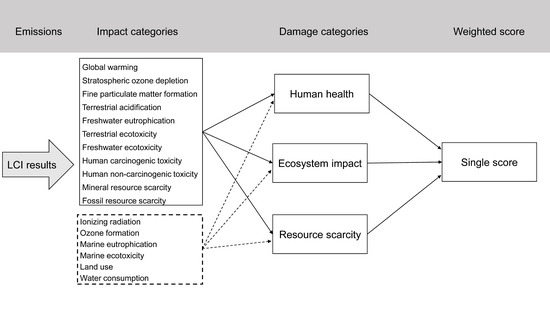
Figure 3.
Life cycle impact assessment (LCIA) framework used in this study with all impact categories shown, divided between those that are individually presented (full box) and those included in the damage assessment and weighted score, but not presented separately (dashed box).
The perspective chosen decides the weight of impacts and the conversion factors used. The hierarchist perspective was stated as the default perspective [60] and was used in this study. Results for both midpoint and endpoint indicators are presented, with the conversion factors in Table S3c in the Supplementary Material used to go from midpoint to endpoint, according to this equation:
where CFe is the endpoint characterisation factor, CFm is the midpoint characterisation factor, c is the perspective (in this study hierarchist), a is the area of protection (human health, ecosystems, resource scarcity), x is the stressor and FM→E,c,a is the midpoint-to-endpoint conversion factor for perspective c and area of protection a [60].
3. Results
3.1. Results for the BEV System
3.1.1. GTG
A GTG impact distribution for the battery electric tractor system can be seen in Figure 4. For all impact categories apart from stratospheric ozone depletion, the battery constituted the majority of the impacts, ranging from 42 to 83% of the gate-to-gate impacts. Other notable components with high impacts were the glider and the chargers. They included many metals, processes and weight, which in the cases translated to high impacts, especially as the charger infrastructure was slightly oversized. Autonomous sensors, although comprising a very small fraction of the total weight, had a relatively high impact. The motor, despite including rare earth metals, had a small impact in all categories compared with the other components.
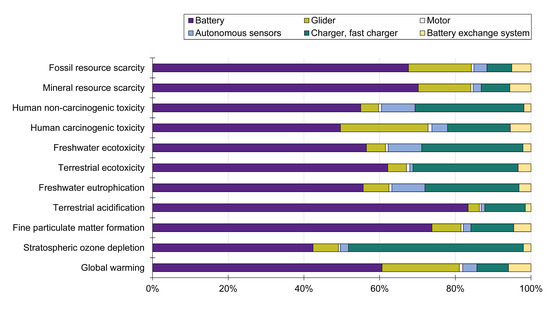
Figure 4.
Gate-to-gate (GTG) impact distribution using midpoint indicators for the battery electric vehicle (BEV) tractor system, including infrastructure. The most commonly used impact categories are shown. “Glider” includes frame, chassis, tyres and wheels, other components and glider assembly.
Because the battery constituted a majority of the impact in most cases, the results of the battery inventory and impact assessment are shown in Figure 5. The material composition showed a roughly equal distribution of metals, with lithium and cobalt being less common by weight than aluminium, copper, nickel and steel. Graphite and the electrolyte both constituted 13% of the weight. The electrodes constituted 49% of the weight and 43% of the global warming potential (GWP). The components made mostly from metal, mainly BMS and module casing, also had a sizeable impact on the climate impact. In the functional unit, the climate impact for the GTG, or manufacturing, phase resulted in 34 kg CO2eq.ha−1 y−1 in total, of which the battery contributed 21 kg CO2eq.ha−1 y−1 or 62%.
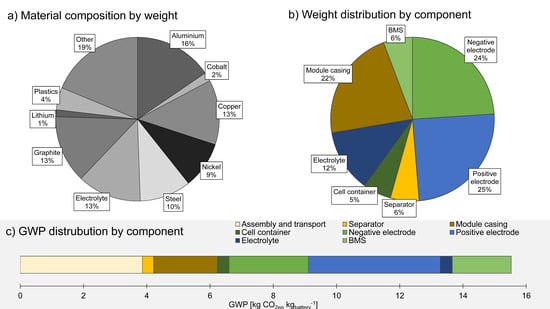
Figure 5.
Weight distribution for the nickel cobalt aluminium-graphite electrode (NCA-C) battery module by (a) material (b) and component, and (c) the global warming potential (GWP) impact by component.
3.1.2. Cradle-to-Grave
The results of the CTG analysis showed that for all impact categories studied, the manufacturing of the batteries and the electricity used as fuel were responsible for the majority of the impacts (Figure 6). This indicates the need to focus on these parts when analysing the overall impact of the system. The impact factors concerning mineral resource scarcity, human toxicity, ecotoxicity, eutrophication and acidification comprised most of the impact from battery manufacturing. The remaining categories, mainly global warming, ozone depletion and fossil resource scarcity, comprised most of the impact from electricity use (66–71%). Apart from these, the highest impact was generally seen for the charger infrastructure and glider manufacturing. The full results can be seen in Supplementary Material S2.
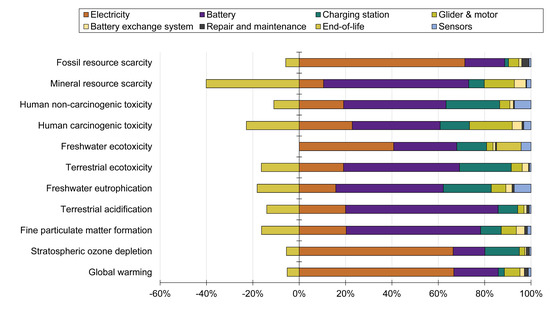
Figure 6.
Cradle-to-grave (CTG) impact distribution using midpoint indicators for the battery electric vehicle (BEV) tractor system, including vehicle and infrastructure manufacturing, use phase and disposal. The most commonly used impact categories are shown. “Glider & motor” includes frame, chassis, tyres and wheels, other components, electric motor and glider assembly.
3.1.3. Damage Assessment
The damage assessment results, calculated as per ReCiPe 2016 [60,61], can be seen in Figure 7. The two major contributors to all three categories (human health, ecosystems and resource scarcity) were electricity use as fuel and the battery, which together contributed 75–89% of the impact. The battery was more significant for human health impact (44%), while electricity was the greatest contributing factor to impacts on ecosystems (68%) and resource scarcity (74%). In total, the BEV system resulted in an impact of 3.11 × 10−4 DALY ha−1 y−1 on human health, 9.09 × 10−7 species ha−1 y−1 on ecosystems and 13.4 USD2013 ha−1 y−1 on resource scarcity.
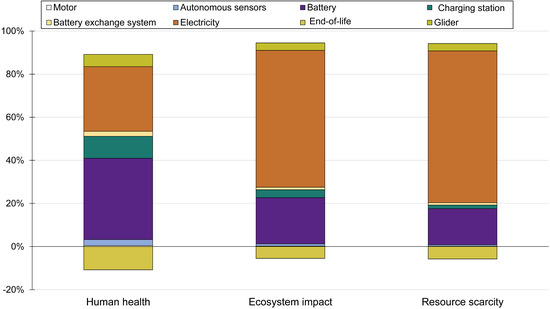
Figure 7.
Damage assessment distribution for the battery electric vehicle (BEV) tractor system, showing impacts from manufacturing to disposal for each component category.
3.2. Comparative Results
Comparisons between the BEV and ICE systems for the midpoint impact factors are shown in Figure 8. The BEV tractor system had a larger impact than the ICE system in all categories in the GTG analysis. This was mainly due to batteries comprising a large proportion of the weight of the BEV. When comparing the CTG results, the BEV system showed lower impact than the ICE system in all impact categories apart from mineral resource scarcity, human carcinogenic toxicity and both kinds of ecotoxicity. The climate impact from the BEV system (102 kg CO2eq.ha−1 y−1) was 35% of that from the ICE system (293 kg CO2eq.ha−1 y−1).
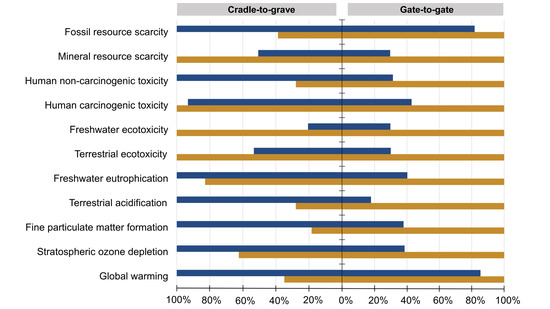
Figure 8.
Midpoint impact comparison of the battery electric vehicle (BEV) system (orange) and the internal combustion engine (ICE) system (dark purple) in gate-to-gate (left) and cradle-to-grave (right) analyses of commonly used impact categories. Values are given as fractions of the largest values, instead of absolute values.
On weighing and summarising the endpoint impact factors (Figure 9), it was found that the BEV system had an overall lower impact than the ICE system in all damage assessment categories: human health (−74%), ecosystem impact (−47%) and resource scarcity (−67%). For the single score, the BEV system had 72% lower impact than the ICE system. The results also showed that the use phase was most impactful for all categories apart from human health, where battery manufacturing had a higher impact than the use phase for the BEV system (Figure 9).
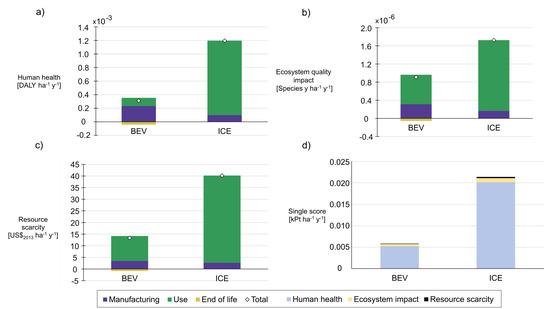
Figure 9.
Comparative results for the battery electric vehicle (BEV) system and internal combustion engine (ICE) system in the damage assessment categories (a) human health, (b) ecosystem impact and (c) resource scarcity, as well as (d) Single score in the Hierarchist perspective according to the guidelines and values in [60].
3.3. Sensitivity and Uncertainty Analysis
A sensitivity analysis with one-at-a-time parameter change was performed. Absolute change, absolute sensitivity and relative sensitivity were calculated for changes in key parameters and are presented for both GWP and the weighted single score (Table 4). The equations used were as follows:
where ΔV is the absolute change, P(V0) is the base value, P(VΔ) is the resulting value after the parameter change (all three in the given impact unit), SA is the absolute sensitivity (fraction), SR is the relative sensitivity (%−1) and ΔP is the change in the parameter (fraction).

Table 4.
Results of sensitivity analysis for key parameters in the model for global warming potential (GWP) and single score values (italic), along with absolute change, absolute sensitivity and relative sensitivity.
Scenario Analysis
To evaluate different scenarios and changes in the assumptions made, key parameters in the model were varied. Only the results for climate impact are shown because it is the most prominently used category in the literature.
Because the Swedish electricity mix is not a good representation of electricity as a fuel in general, the electricity mix was varied. The Swedish mix has a high fraction of renewables and nuclear power, which the global or European mix does not. However, the Swedish margin used as default in this study is more akin to the general European electricity mix. It was found that the ICE system at 293 kg CO2eq.ha−1 y−1 had a higher climate impact than all scenarios except electricity produced from hard coal. The Swedish and European margin electricity mixes had 65% and 60% lower GWP, respectively, with values of 102 and 116 kg CO2eq.ha−1 y−1, respectively. Electricity from hydropower and photovoltaics showed 83% and 77% reductions compared to the ICE case. The Swedish average mix, as described in Itten, Frischknecht and Stucki [40], was also included for comparison, with a total value of 45 kg CO2eq.ha−1 y−1.
Cases involving renewable fuel for the ICE were also considered because that is most likely the first measure taken to reduce GWP impact. Regular retail diesel in Sweden has a desired blend of 17.5% HVO (hydrated vegetable oil) [62], which was included, as was pure HVO. The GWP of HVO varies significantly depending on allocation method and feedstock used [63,64], so the possible range (7–78 g CO2eq. MJ−1) is shown in Figure 10, as well as that of Swedish HVO from 2016 [63,64]. The results showed that the low admixture diesel had a smaller impact than the case using global electricity mix, while the Swedish HVO case had a lower impact than Swedish and European margin electricity. However, it was still outcompeted by Swedish average mix and electricity from renewable sources.
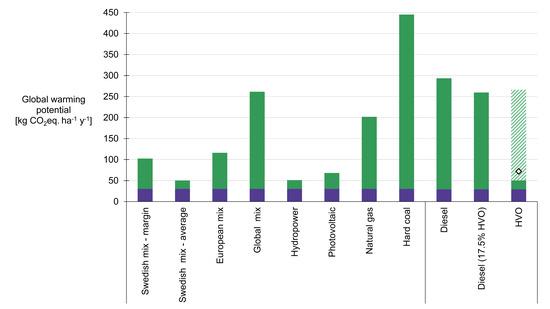
Figure 10.
Scenario analysis of climate impact for different fuel sources for the battery electric vehicle (BEV) and internal combustion engine (ICE) systems, with the vehicle (purple) and fuel (green) presented separately. Disposal and end-of-life were included in the vehicle part, as was repair and maintenance. Swedish margin mix was used as the default in the modelling. The Swedish standard for drop-in blend of HVO in diesel is 17.5% [62]. HVO shown as the range presented in [63] (green diagonals) and with the value of Swedish-produced HVO from [64] (white diamond).
In addition, to account for uncertainty and give a baseline for the environmental potential of the end-of-life phase, a worst case scenario was explored with a different waste management for the BEV case. The reused fraction was instead assumed to be sent to landfill, resulting in a waste scenario with 84% of the material by weight ending up in landfill and 14% being incinerated for energy recovery. The resulting impact in GWP was a change in absolute sensitivity of +12%, and a single score increase of +20%. However, even with both these increases, the BEV system still had lower impacts than the ICE system in the stated categories.
4. Discussion
4.1. Assumptions and Scope
In this analysis, a consequential LCA with system expansion, instead of allocation and marginal energy sources, was used. Consequential LCA tends to lead to higher impacts compared to allocation assessments [29], which could explain why many values obtained in the calculations were higher than the literature values used for verification. However, due to the emerging state of the technology and the experimental nature of the current models, choice of the consequential LCA method can be considered reasonable because it describes a change in the life cycle [29,65].
The functional unit used was set to one hectare for mixed cereal (winter wheat, spring wheat, barley and oats) on a farm in the Uppland region of central Sweden. This functional unit can be considered too specific, but it builds on two previous studies by our research group using the same model, simulations and data [17,18] and allows for precise resolution. The results presented can be used as a general guideline for BEV tractors and show general dynamics that can also be seen in other analyses of battery electric work machines.
4.2. Inventory Model
The model used in this study was mainly based on secondary sources and little to no first-hand information. The early market state of the autonomous BEV tractor technology makes it difficult to find data, and there is no consensus on the best application of this kind of system because machines ranging in size from contemporary tractors to small drones are used. There are also different approaches to charging stations, suitable work and level of autonomy. Therefore, the system described and analysed here should only be regarded as a general exploration of one type of vehicle system, with all the assumptions and simplifications that entails. However, high resolution was sought for the most impactful inventory data points, such as battery production, battery recycling, diesel and electricity.
4.3. Model Outcome and Impact Assessment
The results of the inventory model in SimaPro showed that the BEV system had several parts with large impacts, but in the manufacturing stage, the battery caused the majority of the impact. This was partly due to the chemistry chosen, as several sources [6,7] state that NCA has a higher climate impact in general than other chemistries. It was also partly due to a BEV system with a requirement for several batteries being chosen. The battery exchange system modelled needs more batteries due to the simple dynamic of how the system works, where a depleted battery is quickly replaced with a fully charged one, thus requiring spare batteries. However, 4000 kg of battery is a large amount for a system of this size, even when divided between two vehicles, as each vehicle weighs ~2600 kg without battery. Vehicle systems with a different optimisation solution or system topography can be expected to have different impacts.
On comparing the two systems, it was found that the ICE system generally had a lower impact in the manufacturing stage (GTG), where both the battery production and the additional infrastructure provided a significant impact, on top of the vehicle manufacturing. However, the climate impact of the ICE system was 85% of the impact of the BEV system, so the difference was relatively minor, especially considering that 4000 kg of batteries were produced in the latter system. In all other impact categories apart from fossil resource scarcity, however, the ICE only had 40% or less of the impact of the BEV system, showing the importance of studying several impact categories.
On studying the entire life cycle, it was found that the BEV system had lower impacts than the ICE system in all categories apart from mineral resource scarcity, human carcinogenic toxicity, and terrestrial and freshwater ecotoxicity. The BEV system gave especially high reductions in global warming, fine particles and acidification, mostly due to the higher energy efficiency of the BEV driveline and the lower impact of electricity as a fuel compared with diesel. These factors combined meant that the use phase heavily favoured the BEV system because, even though electricity was still a significant part of the system impact, it had a lower impact than diesel. In addition, some of the high-impact materials from the manufacturing phase could be recycled and reused, further lowering the overall impact. In the damage assessment, the BEV system had lower impacts than the ICE system for human health (−74%), ecosystem impact (−47%) and resource scarcity (−67%). For the single score, BEV had 72% lower impact than the ICE system. It is also worth noting that the data on diesel emissions were from 2007, and since then advances have been made in combustion engines in tractors.
It was found that the manufacturing of batteries and the electricity used as fuel constituted the majority of the impacts, both in the midpoint and endpoint analysis. This suggests that the type and size of battery are very impactful, as is the electricity used. Several sources agree that the impact of batteries is highly relevant in BEV systems, and they present similar findings to those in this study [10,50,56]. The results on the impact of the origin of electricity used are in line with the findings in Nordelöf, Messagie, Tillman, Söderman and Mierlo [10] and Marmiroli, Messagie, Dotelli and Mierlo [55].
4.4. Comparison to Other Studies
As the battery was the most impactful part of the manufacturing process for the BEV system, it was important to check that the values used were in line with those reported in the literature. Verification against literature values on global warming potential (Figure 11) showed that the value obtained for the modelled NCA battery module (155 kg CO2eq kWh−1) was slightly higher than the literature values for NCA batteries (range 120–133 kg CO2eq kWh−1) [34,49,66]. It was also in line with or slightly higher than the general values for nondescribed chemistries in the literature (range 61–175 kg CO2eq kWh−1) [6,7,8,67]. However, some studies report significantly higher impacts, especially Emilsson and Dahllöf [6]. This led to the conclusion that the simulated value was slightly high, but still realistic.
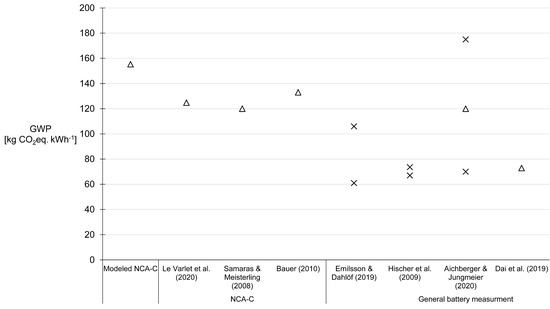
Figure 11.
Comparison of global warming potential (GWP) impact for the modelled nickel cobalt aluminium-graphite electrode (NCA-C) battery and the literature values. When given, the average value is represented by Δ, and high and low values by ×.
The values used for the ICE system were found to be slightly higher than the literature values. The value calculated for the modelled system was 293 kg CO2eq.ha−1 y−1 for the entire life cycle (implement, fertiliser and field emissions excluded). Similar studies have reported values of 140 kg CO2eq.ha−1 y−1 [59] and 160 kg CO2eq.ha−1 y−1 [20] for machinery operations. However, the entire set of field operations was not studied in those cases, and the energy use was lower. In addition, as discussed by Lagnelöv, Larsson, Nilsson, Larsolle and Hansson [17], the energy use of the studied simulated system was slightly higher than corresponding studies in the literature, which most likely carried over for both the ICE and BEV systems. This difference could be explained by the inclusion of more operations, higher data resolution or more energy-demanding soil types (high clay fraction).
The electricity mix used was of high importance. The Swedish margin electricity mix gave a total CTG GWP impact of 102 kg CO2eq.ha−1 y−1, while that for the Swedish average electricity mix was 45 kg CO2eq.ha−1 y−1, i.e., roughly half the total impact. The marginal mix was based on 41% natural gas, 35% wind power and 24% biomass [40], while the average mix consisted of 41% hydro power, 40% nuclear power, 7% wind power, 2.5% biomass and the remainder imported [40]. These values are for 2014 but were verified and found to be reasonably close to the values for 2018 [41,42]. It can be discussed whether one or another of these mixes is the more methodically correct choice of electricity, but such discussion fell outside the scope of this study. The scenario analysis in Section 3.3 gave an overview, instead of a deeper analysis.
4.5. Sensitivity Analysis
Sensitivity analysis based on the resulting response in GWP and single score for parameter changes showed that the energy use of the BEV system had the highest absolute and relative sensitivity for both GWP and single score, as an increase of 25% in the parameter led to an increase of 18% and 10%, respectively. It was followed by the vehicle lifetime, indicating that the assumptions made for these parameters had a high impact. The lifetime of the battery was varied separately and found to have a lower impact for both GWP and single score than the total vehicle lifetime. Glider material use and the size of the motor had very low importance in both categories, as had the battery size for the single score category. However, battery size was impactful for GWP. By ensuring the lowest possible energy use (or the use of cleanest possible energy) and a long lifetime over which to attribute the manufacturing impact, a low impact is more likely.
Exploration of different end-of-life treatments for the BEV showed an increase in GWP (+12%) and single score (+20%). This indicates that waste management is an important part of the environmental impact for these kind of systems and that care should be taken in relevant assumptions made when modelling. In LCAs, recycling is often assumed to be done better or more frequently than the empirical data indicate, and general knowledge of that part of the process is low [6,10,27]. Because a large part of the impact of the BEV system was in the production stage, recycling and waste management are important because they represent ways to mitigate the impact of the manufacturing phase and to reduce the need for virgin material.
Replacing diesel with HVO was shown to be a way to reduce impact for the ICE system, but it was heavily dependent on the feedstock and process used. The literature values vary from 7 to 78 g CO2eq. MJ−1, and hence they suffer from inherent uncertainty in the data, as shown in the review by [2], but also confirm that the interval used here was reasonable. In addition, using HVO would still suffer from reduced driveline efficiency compared to the electric driveline and result in higher overall energy use. However, use of biofuels can be an important initial step to reduce the impact of machinery without replacing the current tractor fleet, a process that is itself likely to have a substantial environmental impact.
Because the use phase was impactful for both the BEV and ICE cases, the fuel used is of great importance. The difference between the best case for electricity (hydropower) and the worst case (hard coal) was close to a nine-fold increase in climate impact. Of all the electricity sources assessed, hard coal was also the only one with a worse climate impact than the ICE system. Electricity origin was also important for the overall results, as there was a large difference in the total GWP of the system when using Swedish (102 kg CO2eq.ha−1 y−1), European (116 kg CO2eq.ha−1 y−1) or global electricity mix (262 kg CO2eq.ha−1 y−1). Choosing Swedish marginal mix over Swedish average mix also doubled the total GWP impact. Based on these results, it seems that all other assumptions were eclipsed by the origin of the electricity in the use phase. This is also partly true for on-road BEVs, but the more intense use of work machinery and the higher yearly energy use in agriculture make the choice of electricity even more important for that class of vehicles. There are large reductions to be gained in changing to a BEV system, but choosing low-impact electricity is vital.
4.6. Implications and Future Research
The results indicate that changing from a diesel vehicle to a battery electric one in a work machinery setting has the potential to drastically decrease the environmental impact in general and GHG emissions in particular over the entire lifespan, even when a large number of batteries is required to be manufactured. While the manufacturing of the batteries was a large part of the impact for the BEV system, it was not detrimental to the overall result. This finding is important for both heavy on-road vehicles and mobile nonroad machinery. Tractors are used intensely during critical points in production (sowing, harvesting) but on a yearly basis work a low number of hours compared to other work machinery. With the tractor system showing a general reduction in environmental impact with a use phase—and therefore fuel use, limited to parts of the year—vehicles with higher yearly usage have a higher potential reduction in environmental impact in the use phase. The outcomes of this study can serve as a precursory positive example of the benefits of transitioning work machinery from diesel to electricity as fuel, and they mark electricity origins and battery manufacturing as important hotspots for further consideration.
The majority of the LCAs performed on BEVs have been focused on GWP as the dominant, or only, impact category. The results impact assessment from this study showed that the different systems, and the different system parts, had different impacts. The BEV systems had a drastic reduction in fine particulate matters compared to the conventional system in the CTG-perspective, but they showed an increase in ecotoxicity. In order to obtain a full picture of the systems impact on the environment both locally and globally, an expanded assessment of several categories and damage categories is beneficial in order to gain important information. The usage of multiple impact categories when performing LCAs has been stated previously [27,60] but remains a recommendation to the industry, policymakers and researchers.
Future research is recommended on the practical applications of vehicle systems similar to the one studied in this article. Verification of simulation data with field trials is an important part in determining the long-term sustainability of the technology. Additional research is also recommended on the secondary effects of using lighter, self-driving tractors, such as soil compaction, marginal field use and increased field trafficability.
5. Conclusions
The LCI and LCIA of an autonomous battery electric tractor system were simulated and calculated, considering a total of eleven midpoint impact categories, three endpoint impact categories and an aggregated single score. The results showed a climate impact of 34 kg CO2eq.ha−1 y−1 for GTG and 102 kg CO2eq.ha−1 y−1 for the entire life cycle (CTG). This was only 35% of the CTG GHG emissions of the diesel tractor system studied (293 kg CO2eq.ha−1 y−1), indicating that there is a high potential for a reduction of lifecycle GHG emissions by using battery electric tractors.
Battery manufacturing and the electricity used for fuel represented important hotspots for all types of impact categories. The BEV system showed a higher impact than the ICE system across all categories in the manufacturing phase, with battery materials and assembly in particular having a large impact.
In a CTG perspective, the BEV system had substantially lower impacts compared to the ICE system in several impact categories, most notably climate change, eutrophication, acidification, fine particulate matter and fossil resource scarcity. The BEV system had a higher impact in categories dealing with mineral resource scarcity, carcinogenic toxicity and freshwater and terrestrial ecotoxicity. A long lifetime, energy-intense use phase and a high recycling rate favours the BEV system.
For both the ICE and BEV systems, the use phase was the most impactful, and the fuel used was highly relevant. For the BEV case, the choice of electricity mix used for recharging resulted in a total GWP impact ranging from 45 (hydropower) to 445 (hard coal) kg CO2eq.ha−1 y−1, i.e., an approximately 10-fold difference. Although all but one of the electricity mixes had a lower impact than the diesel system, low climate impact was highly dependent on low-impact electricity. The choice of electricity was by far the most decisive factor for climate impact, eclipsing all other factors considered, as confirmed by sensitivity analysis.
In CTG endpoint analysis, the BEV system was found to have a notably lower impact than the ICE system in the categories human health (−74%), ecosystem impact (−47%) and resource scarcity (−67%). In the summarised and weighed single score category, the BEV system showed a 72% reduction in impact compared with the conventional ICE system. This result corroborates the hypothesis that changing from a diesel based to an electricity-based system, as described in this study, leads to lower total environmental impacts.
Supplementary Materials
The following are available online at https://www.mdpi.com/article/10.3390/su132011285/s1. S1—Inventory lists [Spreadsheet]; S2—LCI and LCIA results [Spreadsheet]; S3—Chosen impact categories (Table S3a), ReCiPe equivalent impact categories in midpoint and endpoint (Table S3b) and conversion factors for the Hierarchist perspective (Table S3c) [Spreadsheet]
Author Contributions
Conceptualization, O.L., A.L., G.L. and P.-A.H.; Methodology, O.L. and P.-A.H.; Software, O.L.; Validation, O.L., A.L. and P.-A.H.; Formal Analysis, O.L.; Investigation, O.L.; Resources, O.L.; Data Curation, O.L.; Writing—Original Draft Preparation, O.L., A.L., G.L. and P.-A.H.; Writing—Review and Editing, O.L., G.L., and P.-A.H.; Visualization, O.L. and G.L.; Supervision, G.L., A.L. and P.-A.H.; Project Administration, P.-A.H.; Funding Acquisition, P.-A.H. All authors have read and agreed to the published version of the manuscript.
Funding
This research was funded by the Swedish Government research program “STandUP for Energy” and by the Swedish Energy Agency under grant number P44831-1.
Institutional Review Board Statement
Not applicable.
Informed Consent Statement
Not applicable.
Data Availability Statement
The data presented in this study are available in the article; the inventory list is available in Supplementary Material S1, the LCI and LCIA results are available in Supplementary Material S2 and remaining data in the article. The model used for fieldwork simulation is explained in detail in Lagnelöv, Larsson, Nilsson, Larsolle and Hansson [17] and is available upon request from the corresponding author.
Acknowledgments
We thank STandUP for Energy and The Swedish Energy Agency for funding this research.
Conflicts of Interest
The authors declare that they have no known competing financial interests or personal relationships that could have appeared to influence the work reported in this paper.
References
- IPCC. Climate Change 2021: The Physical Science Basis. In Contribution of Working Group I to the Sixth Assessment Report of the Intergovernmental Panel on Climate Change; 2021. Available online: https://www.ipcc.ch/report/ar6/wg1/#FullReport (accessed on 8 October 2021).
- Smith, P.; Bustamante, M.; Ahammad, H.; Clark, H.; Dong, H.; Elsiddig, E.A.; Haberl, H.; Harper, R.; House, J.; Jafari, M.; et al. Agriculture, Forestry and Other Land Use (AFOLU). In Climate Change 2014: Mitigation of Climate Change; Volume Fifth Assessment Report of the Intergovernmental Panel on Climate Change; Edenhofer, O., Pichs-Madruga, R., Sokona, Y., Farahani, E., Kadner, S., Seyboth, K., Adler, A., Baum, I., Brunner, S., Eickemeier, P., et al., Eds.; Cambridge University Press: Cambridge, UK; New York, NY, USA, 2014. [Google Scholar]
- Tubiello, F.N.; Salvatore, M.; Ferrara, A.F.; House, J.; Federici, S.; Rossi, S.; Biancalani, R.; Golec, R.D.C.; Jacobs, H.; Flammini, A.; et al. The Contribution of Agriculture, Forestry and Other Land Use Activities to Global Warming, 1990–2012. Glob. Chang. Biol. 2015, 21, 2655–2660. [Google Scholar] [CrossRef] [Green Version]
- European Comission. A Clean Planet for all—A European Strategic Long-Term Vision for a Prosperous, Modern, Competitive and Climate Neutral Economy. 2018. Available online: https://eur-lex.europa.eu/legal-content/EN/TXT/?uri=CELEX%3A52018DC0773 (accessed on 8 October 2021).
- The Government of Sweden. Fossilfrihet på väg. 2013. Available online: https://www.riksdagen.se/sv/dokument-lagar/dokument/statens-offentliga-utredningar/fossilfrihet-pa-vag---del-2_H1B384d2 (accessed on 8 October 2021).
- Emilsson, E.; Dahllöf, L. Lithium-Ion Vehicle Battery Production—Status 2019 on Energy Use, CO2 Emissions, Use of Metals, Products Environmental Footprint, and Recycling. 2019. Available online: https://www.diva-portal.org/smash/get/diva2:1549551/FULLTEXT01.pdf (accessed on 8 October 2021).
- Dai, Q.; Kelly, J.C.; Gaines, L.; Wang, M. Life Cycle Analysis of Lithium-Ion Batteries for Automotive Applications. Batteries 2019, 5, 48. [Google Scholar] [CrossRef] [Green Version]
- Aichberger, C.; Jungmeier, G. Environmental Life Cycle Impacts of Automotive Batteries Based on a Literature Review. Energies 2020, 13, 6345. [Google Scholar] [CrossRef]
- Hawkins, R.R.; Singh, B.; Majeu-Bettez, G.; Strömman, A.H. Comparative Environmental Life Cycle Assessment of Conventional and Electric Vehicles. J. Ind. Ecol. 2012, 17, 53–64. [Google Scholar] [CrossRef]
- Nordelöf, A.; Messagie, M.; Tillman, A.-M.; Söderman, M.L.; Mierlo, J. Environmental Impacts of Hybrid, Plug-In Hybrid, and Battery Electric Vehicles—What Can We Learn from Life Cycle Assessment? Int. J. Life Cycle Assess. 2014, 19, 1866–1890. [Google Scholar] [CrossRef] [Green Version]
- Grimstad, L.; From, P.J. Thorvald II—A Modular and Re-Configurable Agricultural Robot. IFAC PapersOnLine 2017, 50, 4588–4593. [Google Scholar] [CrossRef]
- Fendt. Fendt e100 Vario: The Battery-Powered Compact Tractor. 2017. Available online: https://www.fendt.com/int/fendt-e100-vario (accessed on 8 October 2021).
- Stöhr, M.; Giglmaier, S.; Berlet, R. Folgenabschätzung zum Einsatz Batteriebetriebener Vollelektrifizierter Landmaschinen. 2015. Available online: https://www.baumgroup.de/fileadmin/interface/files/HDSAVATEVA-142016151526-CJTYIRXHHM.pdf (accessed on 8 October 2021).
- Moreda, G.; Muñoz-García, M.; Barreiro, P. High Voltage Electrification of Tractor and Agricultural Machinery—A review. Energy Convers. Manag. 2016, 115, 117–131. [Google Scholar] [CrossRef]
- Ghobadpour, A.; Boulon, L.; Mousazadeh, H.; Malvajerdi, A.S.; Raifiee, S. State of the Art of Autonomous Agricultural Off-Road Vehicles Driven by Renewable Systems. Energy Procedia 2019, 162, 4–13. [Google Scholar] [CrossRef]
- World Economic Forum. Incentivizing Food Systems Transformation. 2020. Available online: https://www3.weforum.org/docs/WEF_Incentivizing_Food_Systems_Transformation.pdf (accessed on 8 October 2021).
- Lagnelöv, O.; Larsson, G.; Nilsson, D.; Larsolle, A.; Hansson, P.-A. Performance Comparison of Charging Systems for Autonomous Electric Field Tractors Using Dynamic Simulation. Biosyst. Eng. 2020, 194, 121–137. [Google Scholar] [CrossRef]
- Lagnelöv, O.; Dhillon, S.; Larsson, G.; Nilsson, D.; Larsolle, A.; Hansson, P.-A. Cost Analysis of Autonomous Battery Electric Field Tractors in Agriculture. Biosyst. Eng. 2021, 204, 358–376. [Google Scholar] [CrossRef]
- Bacenetti, J.; Lovarelli, D.; Facchinetti, D.; Pessina, D. An Environmental Comparison of Techniques to Reduce Pollutants Emissions Related to Agricultural Tractors. Biosyst. Eng. 2018, 171, 30–40. [Google Scholar] [CrossRef]
- Mantoam, E.J.; Romanelli, T.L.; Gimenez, L.M. Energy Demand and Greenhouse Gases Emissions in the Life Cycle of Tractors. Biosyst. Eng. 2016, 151, 158–170. [Google Scholar] [CrossRef]
- Lovarelli, D.; Bacenetti, J. Exhaust Gases Emissions from Agricultural Tractors: State of the Art and Future Perspectives for Machinery Operators. Biosyst. Eng. 2019, 186, 204–213. [Google Scholar] [CrossRef]
- Ellingsen, L.A.-W.; Hung, C.R.; Strömman, A.H. Identifying Key Assumptions and Differences in Life Cycle Assessment Studies of Lithium-Ion Traction Batteries with Focus on Greenhouse Gas Emissions. Transp. Res. Part D Transp. Environ. 2017, 55, 82–90. [Google Scholar] [CrossRef]
- Peters, J.F.; Baumann, M.; Zimmermann, B.; Braun, J.; Weil, M. The Environmental Impact of Li-Ion Batteries and the Role of Key Parameters—A review. Renew. Sustain. Energy Rev. 2017, 67, 491–506. [Google Scholar] [CrossRef]
- Nordelöf, A.; Grunditz, E.; Lundmark, S.; Tillman, A.-M.; Alatalo, M.; Thiringer, T. Life Cycle Assessment of Permanent Magnet Electric Traction Motors. Transp. Res. Part D Transp. Environ. 2019, 67, 263–274. [Google Scholar] [CrossRef]
- Hernandez, M.; Messagie, M.; Hegazy, O.; Marengo, L.; Winter, O.; Mierlo, J.V. Environmental Impact of Traction Electric Motors for Electric Vehicles Applications. Int. J. Life Cycle Assess. 2017, 22, 54–65. [Google Scholar] [CrossRef]
- Dolganova, I.; Rödl, A.; Bach, V.; Kaltschmitt, M.; Finkbeiner, M. A Review of Life Cycle Assessment Studies of Electric Vehicles with a Focus on Resource Use. Resources 2020, 9, 32. [Google Scholar] [CrossRef] [Green Version]
- Loon, P.v.; Olsson, L.; Klintbom, P. LCA Guidelines for Electric Vehicles. Research Institute of Sweden: Gothenburg, Sweden, 2018; Available online: https://www.ri.se/sites/default/files/2019-06/Bilaga%202%2C%20LCA%20Guidelines%20for%20electric%20vehicles.pdf (accessed on 8 October 2021).
- Arvidsson, R.; Tillman, A.-M.; Sandén, B.A.; Janssen, M.; Nordelöf, A.; Kushnir, D.; Molander, S. Environmental Assessment of Emerging Technologies: Recommendations for Prospective LCA. J. Ind. Ecol. 2018, 22, 1286–1294. [Google Scholar] [CrossRef] [Green Version]
- Plevin, R.J.; Delucchi, M.A.; Creutzig, F. Using Attributional Life Cycle Assessment to Estimate Climate-Change Mitigation Benefits Misleads Policy Makers. J. Ind. Ecol. 2014, 18, 73–83. [Google Scholar] [CrossRef]
- ISO. Environmental management—Life Cycle Assessment—Principles and Framework. ISO 14040:2006. 2006. Available online: https://www.iso.org/standard/37456.html (accessed on 8 October 2021).
- PRé Sustainability. SimaPro Database Manual—Methods Library. 2020. Available online: https://simapro.com/wp-content/uploads/2020/10/DatabaseManualMethods.pdf (accessed on 8 October 2021).
- Wolff, S.; Seidenfus, M.; Gordon, K.; Álvarez, S.; Kalt, S.; Lienkamp, M. Scalable Life-Cycle Inventory for Heavy-Duty Vehicle Production. Sustainability 2020, 12, 5396. [Google Scholar] [CrossRef]
- Nemecek, T.; Kägi, T. Life Cycle Inventories of Agricultural Production Systems; Swiss Centre of Life Cycle Inventories: Duebendorf, Sweden, 2007; Available online: https://www.researchgate.net/publication/263239333_Life_Cycle_Inventories_of_Agricultural_Production_Systems (accessed on 8 October 2021).
- Le Varlet, T.; Schmidt, O.; Gambhir, A.; Few, S.; Staffel, I. Comparative Life Cycle Assessment of Lithium-Ion Battery Chemistries for Residential Storage. J. Energy Storage 2020, 28, 101230. [Google Scholar] [CrossRef]
- Nordelöf, A.; Grunditz, E.; Tillman, A.-M.; Thiringer, T.; Alatalo, M. A Scalable Life Cycle Inventory of an Electrical Automotive Traction Machine—Technical and Methodological Description. Version 1.01. SPINE database. 2017. Available online: http://cpmdatabase.cpm.chalmers.se/DataReferences/LCI_model_report_PMSM_v1.0.pdf (accessed on 8 October 2021).
- Lucas, A.; Silva, C.A.; Neto, R.C. Life Cycle Analysis of Energy Supply Infrastructure for Conventional and Electric Vehicles. Energy Policy 2012, 41, 537–547. [Google Scholar] [CrossRef]
- Solus Group. Automatic Transfer Carriages—Battery Handling Equipment. 2019. Available online: https://solusgrp.com/battery-handling-equipment.html (accessed on 8 October 2021).
- Toyota Material Handling. Pedestrian Lowlifter Truck 1.8–2.5 ton. Version 7. 2020, pp. 1–4. Available online: https://media.toyota-forklifts.eu/published/22665_Original%20document_toyota%20mh.pdf (accessed on 8 October 2021).
- Jungbluth, N. Erdöl; Swiss centre for life cycle inventories: Duebendorf, Switzerland, 2007; Available online: http://datalib.edina.ac.uk/catalogue/eco-invent (accessed on 8 October 2021).
- Itten, R.; Frischknecht, R.; Stucki, M. Life Cycle Inventories of Electricity Mixes and Grid. 2014. Available online: https://www.researchgate.net/profile/Rene-Itten/publication/297715321_Life_Cycle_Inventories_of_Electricity_Mixes_and_Grid/links/596756b4a6fdcc18ea661c35/Life-Cycle-Inventories-of-Electricity-Mixes-and-Grid.pdf (accessed on 8 October 2021).
- Swedish Environmental Protection Agency. National Inventory Report Sweden 2020; Swedish Environmental Protection Agency: Stockholm, Swedish, 2020. Available online: https://unfccc.int/documents/224123 (accessed on 8 October 2021).
- The Swedish Energy Agency. Energiläget 2020. 2020. Available online: https://energimyndigheten.a-w2m.se/Home.mvc?ResourceId=168344 (accessed on 8 October 2021).
- ASABE. Agricultural Machinery Management Data; American Society of Agricultural and Biological Engineers: St. Joseph, ML, USA, 2011. [Google Scholar]
- Duce, A.D.; Egede, P.; Öhlschläger, G.; Dettmer, T.; Althaus, H.-J.; Bütler, T.; Szczechowicz, E. Guidelines for the LCA of Electric Vehicles, 285571. 2013. Available online: https://www.researchgate.net/publication/291135663_eLCAr_Guidelines_for_the_LCA_of_electric_vehicles (accessed on 8 October 2021).
- Siret, C.; Tytgat, J.; Ebert, T.; Mistry, M.; Thirlaway, C.; Schultz, B.; Xhantopoulos, D.; Wiaux, J.-P.; Chanson, C.; Tomboy, W.; et al. PEFCR—Product Environmental Footprint Category Rules for High Specific Energy Rechargeable Batteries for Mobile Applications, European Comission. 2018. Available online: https://ec.europa.eu/environment/eussd/smgp/pdf/PEFCR_Batteries.pdf (accessed on 8 October 2021).
- Lee, J.; Cho, H.-j.; Choi, B.; Sung, J.; Lee, S.; Shin, M. Life Cycle Assessment of Tractors. Int. J. Life Cycle Assess. 2000, 5, 205–208. [Google Scholar] [CrossRef]
- Majeau-Bettez, G.; Hawkins, T.R.; Strømman, A.H. Life Cycle Environmental Assessment of Lithium-ion and Nickel Metal Hydride Batteries for Plug-in Hybrid and Battery Electric Vehicles. Environ. Sci. Technol. 2011, 45, 4548–4554. [Google Scholar] [CrossRef] [PubMed]
- Ellingsen, L.A.-W.; Majeau-Bettez, G.; Singh, B.; Srivastava, A.K.; Valøen, L.O.; Strømman, A.H. Life Cycle Assessment of a Lithium-Ion Battery Vehicle Pack. J. Ind. Ecol. 2014, 18, 113–124. [Google Scholar] [CrossRef] [Green Version]
- Bauer, C. Oekobilanz von Lithium-Ionen Batterien—Analyse der Herstellung von Energiespeichern für den Einsatz in Batteriefahrzeugen. 2010. Available online: https://www.bundestag.de/resource/blob/700558/3b2ea0c2f3f021672be4759f00a1c474/WD-8-099-18-S-pdf-data.pdf (accessed on 8 October 2021).
- Notter, D.A.; Gauch, M.; Widmer, R.; Wäger, P.; Stamp, A.; Zah, R.; Althaus, H.-J. Contribution of Li-ion Batteries to The Environmental Impact of Electric Vehicles. Environ. Sci. Technol. 2010, 44, 6550–6556. [Google Scholar] [CrossRef]
- Nordelöf, A.; Grunditz, E.; Tillman, A.-M.; Thiringer, T.; Alatalo, M.A. Scalable Life Cycle Inventory of an Electrical Automotive Traction Machine—Part I: Design and Composition. Int. J. Life Cycle Assess. 2018, 23, 55–69. [Google Scholar] [CrossRef] [Green Version]
- Spielmann, M.; Bauer, C.; Dones, R.; Tuchschmid, M. Life Cycle Inventories of Transport Services; Swiss Centre for Life Cycle Inventories: Dübendorf, Switzerland, 2007. [Google Scholar]
- Mousazadeh, H.A. Technical Review on Navigation Systems of Agricultural Autonomous Off-road Vehicles. J. Terramech. 2013, 50, 211–232. [Google Scholar] [CrossRef]
- Hirz, M.; Walzel, B. Sensor and Object Recognition Technologies for Self-Driving Cars. Comput. Des. Appl. 2018, 15, 501–508. [Google Scholar] [CrossRef] [Green Version]
- Marmiroli, B.; Messagie, M.; Dotelli, G.; Mierlo, J.V. Electricity Generation in LCA of Electric Vehicles: A Review. Appl. Sci. 2018, 8, 1384. [Google Scholar] [CrossRef] [Green Version]
- Pridemore, A.; Hampshire, K.; German, R.; Fons, J.; Unterstaller, A.; Reichel, A.; Lukewille, A.; Peris, E.; Jozwicka, M.; Adams, M.; et al. Electric Vehicles from Life Cycle and Circular Economy Perspectives; European Environment Agency: Copenhagen, Denmark, 2018.
- Steiner, R.; Frischknecht, R. Life Cycle Inventories of Metal Processing and Compressed Air Supply; Swiss Centre for Life Cycle Inventories: Dübendorf, Switzerland, 2007. [Google Scholar]
- Cooney, G.; Hawkins, T.R.; Marriot, J. Life Cycle Assessment of Diesel and Electric Public Transportation Buses. J. Ind. Ecol. 2013, 17, 689–699. [Google Scholar] [CrossRef] [Green Version]
- Mousazadeh, H.; Keyhani, A.; Javadi, A.; Mobli, H.; Abrinia, K.; Sharifi, A. Life-Cycle Assessment of A Solar Assist Plug-in Hybrid Electric Tractor (SAPHT) in Comparison with A Conventional Tractor. Energy Convers. Manag. 2011, 52, 1700–1710. [Google Scholar] [CrossRef]
- National Institute for Public Health and the Environment. ReCiPe 2016 v1.1—Report I: Characterization; Ministry of Health, Welfare and Sport: Bilthoven, The Netherlands, 2016.
- Huijbregts, M.A.J.; Steinmann, Z.; Elshout, P.M.F.; Stam, G.; Verones, F.; Vieira, M.; Zijp, M.; Hollander, A.; van Zelm, R. ReCiPe2016: A Harmonised Life Cycle Impact Assessment Method at Midpoint and Endpoint Level. Int. J. Life Cycle Assess. 2017, 22, 138–147. [Google Scholar] [CrossRef]
- The Swedish Energy Agency. Drivmedel 2019—Redovisning Av Rapporterade Uppgifter Enligt Drivmedelslagen, Hållbarhetslagen Och Reduktionsplikten. ISSN 1403–1892. 2020. Available online: https://www.energimyndigheten.se/globalassets/nyheter/2020/er-2020_26-drivmedel-2019.pdf (accessed on 8 October 2021).
- Soam, S.; Hillman, K. Factors Influencing the Environmental Sustainability and Growth of Hydrotreated Vegetable Oil (HVO) in Sweden. Bioresour. Technol. Rep. 2019, 7, 100244. [Google Scholar] [CrossRef]
- Källmén, A.; Andersson, S.; Rydberg, T. Well-to-Wheel LCI Data for HBO Fuels on the Swedish Market; f3—The Swedish Knowledge Centre for Renewable Transportation Fuels: Gothenburg, Sweden, 2019; Available online: https://f3centre.se/app/uploads/f3-23-17_2019-04_K%C3%A4llm%C3%A9n-et-al_Rev_190508_FINAL.pdf (accessed on 8 October 2021).
- Ekvall, T. Cleaner Production Tools: LCA and Beyond. J. Clean. Prod. 2002, 10, 403–406. [Google Scholar] [CrossRef]
- Samaras, C.; Meisterling, K. Life Cycle Assessment of Greenhouse Gas Emissions from Plug-in Hybrid Vehicles: Impliciations for Policy. Environ. Sci. Technol. 2008, 42, 3170–3176. [Google Scholar] [CrossRef] [Green Version]
- Hischier, R.; Althaus, H.-J.; Bauer, C.; Doka, G.; Frischknecht, R.; Jungbluth, N.; Margni, M.; Nemecek, T.; Simons, A.; Spielmann, A. Documentation of Changes Implemented In ecoinvent Data v2.1; Ecoinvent Report no.16; Ecoinvent: Zurich, Switzerland, 2009. [Google Scholar]
Publisher’s Note: MDPI stays neutral with regard to jurisdictional claims in published maps and institutional affiliations. |
© 2021 by the authors. Licensee MDPI, Basel, Switzerland. This article is an open access article distributed under the terms and conditions of the Creative Commons Attribution (CC BY) license (https://creativecommons.org/licenses/by/4.0/).